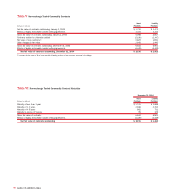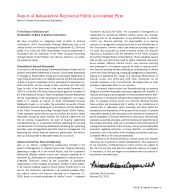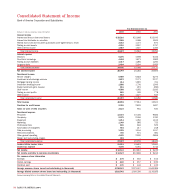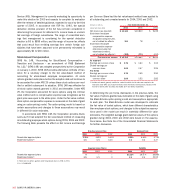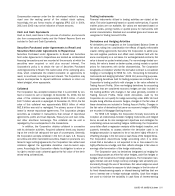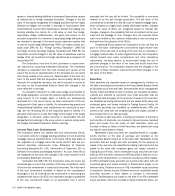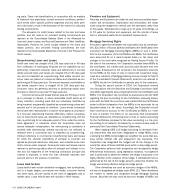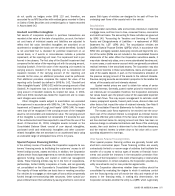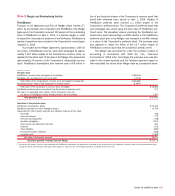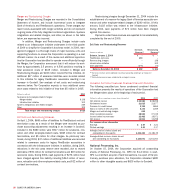Bank of America 2004 Annual Report Download - page 101
Download and view the complete annual report
Please find page 101 of the 2004 Bank of America annual report below. You can navigate through the pages in the report by either clicking on the pages listed below, or by using the keyword search tool below to find specific information within the annual report.
Bank of America Corporation and its subsidiaries (the Corporation)
through its banking and nonbanking subsidiaries, provide a diverse
range of financial services and products throughout the United States
and in selected international markets. At December 31, 2004, the
Corporation operated its banking activities primarily under three
charters: Bank of America, National Association (Bank of America, N.A.),
Bank of America, N.A. (USA) and Fleet National Bank.
On April 1, 2004, the Corporation acquired all of the outstand-
ing stock of FleetBoston (the Merger). FleetBoston’s results of oper-
ations were included in the Corporation’s results beginning on April 1,
2004. The Merger was accounted for as a purchase. For informa-
tional and comparative purposes, certain tables have been expanded
to include a column entitled FleetBoston, April 1, 2004. This column
represents balances acquired from FleetBoston as of April 1, 2004,
including purchase accounting adjustments.
In order to more closely align with the scope of its businesses,
the Corporation has renamed each of its business segments.
Consumer and Small Business Banking has been renamed Global
Consumer and Small Business Banking,Commercial Banking is now
called Global Business and Financial Services,Global Corporate and
Investment Banking is now called Global Capital Markets and
Investment Banking and Wealth and Investment Management has
been renamed Global Wealth and Investment Management.
Note 1
Summary of Significant Accounting Principles
Principles of Consolidation and Basis of Presentation
The Consolidated Financial Statements include the accounts of the
Corporation and its majority-owned subsidiaries, and those variable
interest entities (VIEs) where the Corporation is the primary benefici-
ary. All significant intercompany accounts and transactions have been
eliminated. Results of operations of companies purchased are
included from the dates of acquisition. Certain prior period amounts
have been reclassified to conform to current period presentation.
Assets held in an agency or fiduciary capacity are not included in the
Consolidated Financial Statements. The Corporation accounts for
investments in companies in which it owns a voting interest of 20 per-
cent to 50 percent and for which it may have significant influence
over operating and financing decisions using the equity method of
accounting. These investments are included in Other Assets and the
Corporation’s proportionate share of income or loss is included in
Other Income.
The preparation of the Consolidated Financial Statements in
conformity with accounting principles generally accepted in the
United States requires management to make estimates and
assumptions that affect reported amounts and disclosures. Actual
results could differ from those estimates and assumptions.
During the second quarter of 2004, the Corporation’s Board of
Directors (the Board) approved a 2-for-1 stock split in the form of a
common stock dividend effective August 27, 2004, to common share-
holders of record on August 6, 2004. All prior period common share
and related per common share information has been restated to
reflect the 2-for-1 stock split.
Recently Issued Accounting Pronouncements
In January 2003, the Financial Accounting Standards Board (FASB)
issued FASB Interpretation No. 46, “Consolidation of Variable Interest
Entities, an interpretation of ARB No. 51” (FIN 46), which provides a
framework for identifying VIEs and determining when a company
should include the assets, liabilities, noncontrolling interests and
results of activities of a VIE in its consolidated financial statements.
The Corporation adopted FIN 46 on July 1, 2003, and consolidated
approximately $12.2 billion of assets and liabilities related to certain
of our multi-seller asset-backed commercial paper (ABCP) conduits.
On October 8, 2003, one of these entities, Ranger Funding Company
(RFC) (formerly known as Receivables Capital Corporation), entered
into a Subordinated Note Purchase Agreement (the Note) with an
unrelated third party which reduced our exposure to this entity’s
losses under liquidity and credit agreements as these agreements
are senior to the Note. This Note was issued in the principal amount
of $23 million, an original maturity of five years and pays interest at
23 percent. Proceeds from the issuance of the Note were deposited
into a separate account and may be used to cover losses incurred by
RFC. Upon RFC’s issuance of this Note, the Corporation evaluated
whether the Corporation continued to be the primary beneficiary of
RFC and determined that the unrelated party which purchased the
Note absorbed over 50 percent of the expected losses of RFC. We
determined the amount of expected loss through mathematical analy-
sis utilizing a Monte Carlo model that incorporates the cash flows
from RFC’s assets and utilizes independent loss information. The
noteholder is therefore the primary beneficiary of and is required to
consolidate the entity. As a result of the sale of the Note, we decon-
solidated approximately $8.0 billion of the previously consolidated
assets and liabilities of the entity. The impact of this transaction on
the Consolidated Statement of Income was the reduction in Interest
Income of approximately $1 million and the reclassification of approx-
imately $37 million from Net Interest Income to Noninterest Income
for 2003. At December 31, 2004, this entity had total assets of
Notes to Consolidated Financial Statements
Bank of America Corporation and Subsidiaries
100 BANK OF AMERICA 2004


